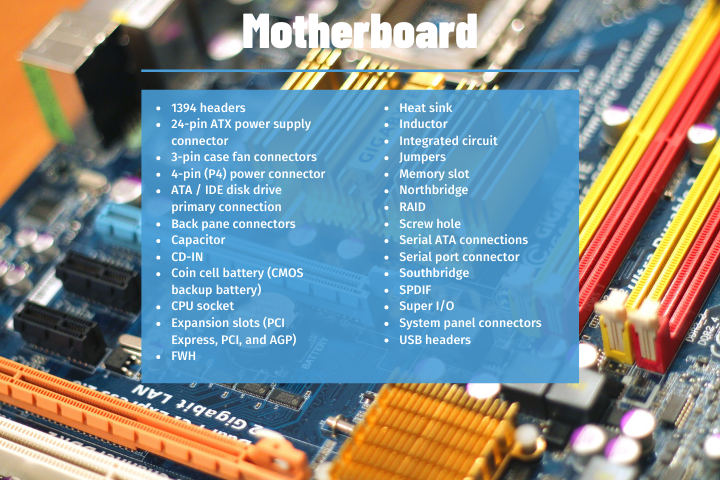A motherboard is one of the most essential parts of a computer. A motherboard is a printed circuit board (PCB) that holds many of the key components of a computer, including the CPU, RAM, and storage drives. The motherboard allows these components to communicate with each other and transfer data between them.

In addition to these core components, a motherboard will also have slots for expansion cards (e.g., graphics cards, sound cards, etc.), connectors for input/output devices (e.g., USB ports, HDMI ports, etc.), and power connectors.
There are many different types of motherboards with features such as video cards, sound chips, or RAID controllers to increase performance for certain tasks.
Table of Contents
How Does a Motherboard Work?
A motherboard essentially acts as a hub that allows all of the different components inside a computer to communicate with each other. When you press a key on your keyboard or move your mouse, that information has to travel from those input devices to the CPU so that it can be processed.
The data is then transferred to the RAM so that it can be accessed quickly by the CPU when needed. From there, the data is either stored on one of your storage drives or sent to an output device like your monitor or speakers. All of this data transfer happens through the motherboard.
Motherboard Components
All motherboard components
- 1394 headers
- 24-pin ATX power supply connector
- 3-pin case fan connectors
- 4-pin (P4) power connector
- ATA / IDE disk drive primary connection
- Back pane connectors
- Capacitor
- CD-IN
- Coin cell battery (CMOS backup battery)
- CPU socket
- Expansion slots (PCI Express, PCI, and AGP)
- FWH
- Heat sink
- Inductor
- Integrated circuit
- Jumpers
- Memory slot
- Northbridge
- RAID
- Screw hole
- Serial ATA connections
- Serial port connector
- Southbridge
- SPDIF
- Super I/O
- System panel connectors
- USB headers
Most important components
Here’s a brief overview of some of the most important motherboard components:
- The central processing unit (CPU) is the brain of your computer. It handles all of the computational tasks that keep your computer running. The CPU is typically located in a socket on the motherboard.
- The memory (or RAM) is where your computer stores data that it needs to access quickly. This can include things like the operating system, application programs, and user data. RAM is typically located on the motherboard, in the form of DIMM or SO-DIMM modules.
- The power supply unit (PSU) provides power to all of the other components in your computer. It typically plugs into a socket on the motherboard. The PSU regulates the voltage and current to make sure that components don’t fry when they’re turned on.
- The graphics processing unit (GPU) is responsible for generating the images that you see on your monitor. The GPU is typically a separate card that plugs into a slot on the motherboard. Many motherboards also have integrated GPUs, which are less powerful but require less power and generate less heat.
Types of Motherboards
Motherboard size ranges from ATX to Mini-ITX and they are classified according to the size of their form factor or shape.
- AT
- ATX
- Baby AT
- BTX
- DTX
- LPX
- Full AT
- Full ATX
- microATX
- NLX
Can the Motherboard be Repaired?
Yes, the motherboard can be repaired. A motherboard repair is a lengthy process and requires experience to do it properly without frying other components in the computer or damaging its motherboard any further.
The cost of a damaged motherboard will depend on what type of damage it has incurred and how much work needs to be done to repair that damage.
Some common types of damage include broken capacitors, cracked solder joints due to overheating, shorts between traces caused by heavy vibration or shock from dropping your laptop while plugged into an outlet (everyone’s favorite), etc…
How Long Does a Motherboard Last?
A normal motherboard cab last 3-7 years. The life of a motherboard is determined by the type of power supply it has. If you have a motherboard with an “ATX” form factor, then your motherboard will last for about three to five years on average before needing replacement.
For instance, Intel recommends that if you’re using their motherboards and are running them at 100% capacity all the time, then they recommend replacing them every 36 months.
